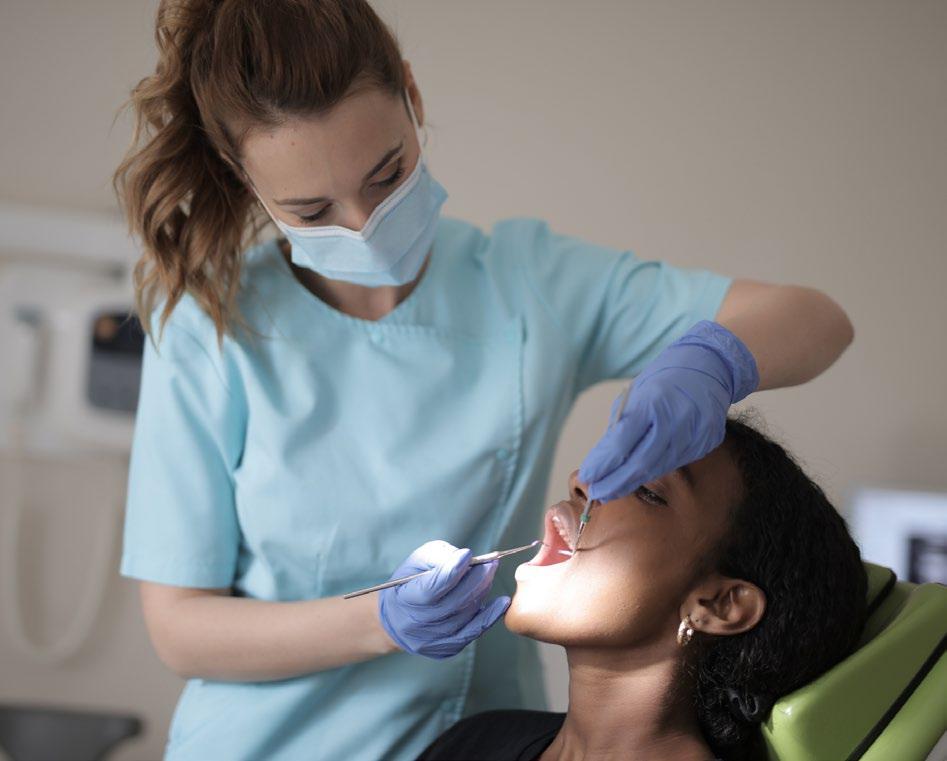


PPP® Sample Patient Termination Letters
One of the most frequent calls we receive on the PPP® Risk Management Support Line is when dental practices seek assistance with dismissing a patient from the practice. When dismissing a patient, it is important to be mindful of the patient’s well-being and your professional obligations to the patient, as well as the safety of you and your staff and the best practices to avoid potential ramifications.
There are a variety of reasons why dentists come to the decision to terminate a dentist-patient relationship, which makes it challenging to have a one-size-fits-all form for each scenario. We’ve created multiple Sample Patient Termination Letters to address the most frequent reasons for patient termination. They include:
• General Termination – no specific reason needed
• Termination for an Overdue Account
• Termination for Missed/Cancelled Appointments
• Termination for a Breakdown of Communication or Trust
• Termination for Inappropriate Behavior
• Termination for Inactive Recall Patient

GOOD RISK MANAGEMENT PRACTICES REDUCE EXTRACTION RISKS
By John Vaselaney, DDS, ARM; Director of Risk Management
Extractions are an essential part of dentistry and are performed countless times each day by dentists across the country. They also continue to be significant drivers of dental malpractice claim activity. Extractions are the second most common dental procedure cited and represent nearly 21% of the total claim dollars spent (third highest) in our program among claims where a dental procedure is noted.
Every dentist and patient wants a safe and successful outcome for every extraction, free of clinical complications and resulting in a satisfied patient. Let’s review the processes and procedures that help achieve those results and reduce your extraction risks.
Identifying and Assessing the Risks
To properly manage extraction risks, we first need to identify the adverse events and outcomes associated with extractions, particularly those that lead
In addition to the Sample Patient Termination Letters, we’ve put together some helpful instructions when executing a patient termination letter, such as best practices when sending the letter, when it’s not recommended to terminate a patient, and being aware of your state’s requirements.
We welcome you to request these documents to utilize in your practice. Please submit your basic contact information here and we will deliver them to you via email.
If you’d like to learn more about effective patient termination, please check out our blog post on the PPP® website.

to malpractice claims. Every dentist knows the most common risks of extraction: pain, bleeding, swelling and infection. Depending on the location of the tooth in question, additional risks may include more serious concerns such as nerve damage in the form of permanent numbness or tingling, a perforation into the maxillary sinus, or jaw fracture.
We can also look at claimed injuries and allegations to help us understand extraction risks. The most significant claim settlements involving extractions have been for postoperative nerve injuries, postoperative bleeding, and complications of sedation done to facilitate extractions.
Other allegations involving extractions include:
• Failure to diagnose the need for extraction, including inadequate or improper patient evaluation, insufficient or poor radiographs, or a missed or inaccurate diagnosis
• Failure to refer to a specialist in oral and maxillofacial surgery, whether before treatment or after a complication or adverse event has occurred
• Inadequate or improper informed consent
• Examples include allegations that the patient was not properly informed of a known, foreseeable risk or complication of the procedure, or that the patient was not properly informed of treatment alternatives such as referral to an oral surgeon.
• The extraction was performed incorrectly or below the standard of care and resulted in an injury.
• Examples of this type of allegation assert the patient suffered a nerve injury, was hospitalized, had an injury to adjacent teeth or soft tissues, or had damage to the maxillary sinuses. It also includes allegations that the incorrect tooth was extracted, the dentist failed to remove the entire tooth, or the dentist improperly managed an adverse extraction outcome.
Managing the Risks
As with most dental procedures, there are a variety of ways to manage the risk, whether you’re avoiding it altogether or taking it on. Looking through a risk avoidance lens, we encourage dentists to select extraction cases that are within their comfort zone of education, training, and clinical ability, and to refer those that are not. For example, consider referring impacted teeth and those with complicated root anatomy, proximity to the maxillary sinus or inferior alveolar nerve, and teeth that are severely damaged that pose an increased difficulty to remove. We also
recommend dentists consider referring patients who have previously had difficulties with extractions and those with medical conditions or concerns that would pose a greater risk.
If you choose to go ahead with the extraction, you’ll need to address a variety of risks relating to both the patient and the clinical procedure. That begins with a thorough review of the patient’s medical history and physical status. Assess their physical condition and ability to tolerate the proposed extraction. What underlying medical conditions exist and what medications are they taking – and how does that affect your care? Be sure to obtain the vital signs of blood pressure and pulse as part of your assessment.
It’s wise to confirm that patients with compromised or complex medical histories have been evaluated by their physician or primary care provider and that you learn of any recommendations for adding or altering medication regimens that the patient must follow. Some examples include antibiotics for infective endocarditis, anticoagulant therapy, diabetic management, and the use of anxiolytics. If such a medical recommendation has been made, it is essential that you confirm with the patient prior to the delivery of local anesthesia that they have, in fact, followed the recommended course of action.
Now let’s look at some clinical dental procedural steps to improve patient safety and reduce extraction risks. That starts with having a preoperative radiograph that shows the entire tooth, root structure, and surrounding structures. Depending on the location and angulation of the tooth, you may need multiple radiographic views. This may be in the form of multiple periapical radiographs, or it may necessitate a panoramic image or even cone beam tomography to fully assess the tooth and the risks of performing the procedure. We are increasingly seeing CBCT used by oral and maxillofacial surgeons during the assessment of third molar positions and risks.
A frequent allegation is that the wrong tooth was extracted. A simple step to prevent this is to take a timeout before starting – even before the local anesthetic – to verify more
than once that the proper tooth is to be extracted. Check in the examination record that the tooth was charted properly and even ask the patient to confirm which tooth is to be extracted.
Next, plan what you’ll need to do before picking up an instrument. Do you need to section the tooth? Do you need to make an incision and reflect a flap? If so, determine when in your procedural sequence you’ll be taking those steps and just how you’ll accomplish them.
Use sound surgical principles and techniques during the procedure, such as for asepsis, hemostasis, thorough wound debridement, and the atraumatic handling of tissues. Be careful with instruments and avoid damaging neighboring teeth, restorations, and soft tissues.
Remove the tooth completely, including all roots and root fragments, unless its proximity to a vital structure (such as the inferior alveolar nerve or the maxillary sinus) makes it prudent to leave it in place. If you do need to leave a root fragment behind, be certain to inform the patient that you’re doing so and document it in the patient’s chart.
Managing Complications and the Postoperative Period
Not every extraction goes exactly as planned. If you encounter difficulty during the extraction, stabilize the patient and refer if the situation is beyond your skills, experience, or comfort level.
To help prevent postoperative complications, give patients clearly stated postoperative instructions both verbally and in writing, since many patients forget what they are told verbally. Emphasize the aspects of the instructions that are most pertinent to the patient, as this is an excellent opportunity to manage the patient’s postoperative expectations. It’s also wise to require patients to return for a postop evaluation if you wish to assess the progress of their healing.
Part of your postoperative instructions should be to inform patients how to reach you after hours if they have a postoperative problem of some urgency. Providing this information in advance of a problem helps allay many patient worries.
If a patient does develop postop sequelae such as dry socket, infection, or severe swelling, continue to re-evaluate the patient until all issues are resolved and thoroughly document the follow-up care in the chart.
Informed Consent
It is essential that the patient’s informed consent is obtained prior to extracting any tooth. Remember that informed consent is not simply getting the patient to sign their name on a document – it’s the process through which a patient is provided enough information to make an informed, reasoned decision about the proposed care.
Any informed consent discussion must include a number of key topics, including a review of the diagnosis, the recommended treatment, and the benefit to the patient of having the procedure. It also includes a review of the reasonable alternatives and the known risks that have a reasonable likelihood of occurring.
For an extraction, the diagnosis is most commonly pain, caries, or mobility, although other clinical rationales exist. Be sure to inform the patient of those that apply to the extraction at hand. In many cases, a reasonable alternative to extraction is endodontic therapy followed by restoration of the tooth in question. However, there are plenty of instances when there simply is no reasonable alternative to extraction. In those cases, the dentist should state that fact and indicate it on the informed consent form.
Referral to an oral surgeon is another reasonable alternative that should be offered to patients. Doing so helps obviate potential allegations of failure to refer that are often alleged in extraction claims.
Your disclosure of the risks of the extraction should include those that have a reasonable likelihood of occurring as well as those that a reasonable patient would
want to know about to make their decision. Be certain to include the common risks discussed earlier as well as the more significant risks that may occur based on the patient or the clinical presentation of the tooth to be extracted. Also, if you foresee a complication that is within your skill level and you plan to proceed, inform the patient before the extraction as part of the informed consent process.
These risks should be part of your informed consent discussion with the patient in addition to being listed on the informed consent form the patient signs.
Documenting Your Care
The thorough documentation of extractions from diagnosis through postoperative care is essential to your risk management efforts. To that end, the patient’s chart should show:
• Why the extraction was clinically necessary, including any subjective statements or complaints from the patient in quotation marks
• Your objective clinical findings and diagnosis of the tooth. Remember that “extraction” is a procedure, not a diagnosis.
• What was done during the extraction, including (but not limited to) such tasks as local anesthetic use (agent, concentration, volume, etc.), incision, flap reflection, sectioning, bone removal or smoothing, irrigation, bone grafting, and suturing
• Any unexpected or adverse events that occurred during the procedure or outcomes after the procedure and what was done to address them
• Postoperative medications and prescriptions, including any recommended over-the-counter medications
• Postoperative instructions given, including any recommendations for a return visit
Putting It All Together
Extractions can be challenging procedures that are often needed for challenging patients. Dentists can improve patient safety and reduce the risk of a clinical complication or a claim by using sound risk management techniques that include referrals, sound clinical decision making and care, thorough informed consent processes, and comprehensive documentation.


We’re eager to share our knowledge with you! Our Proactive Practice Pointers offer practical guidance in under a minute, whether you’re at your desk, between operatories or even on your couch. Just scroll through the PPP®’s social media pages or YouTube channel for helpful tips and reminders from our Proactive Practice Pointers!
Follow us on Instagram, X (formerly Twitter), Facebook, LinkedIn and YouTube! Follow our handles @PPPDentalPlan or The Professional Protector Plan® for Dentists to have these valuable pointers right at your fingertips!




